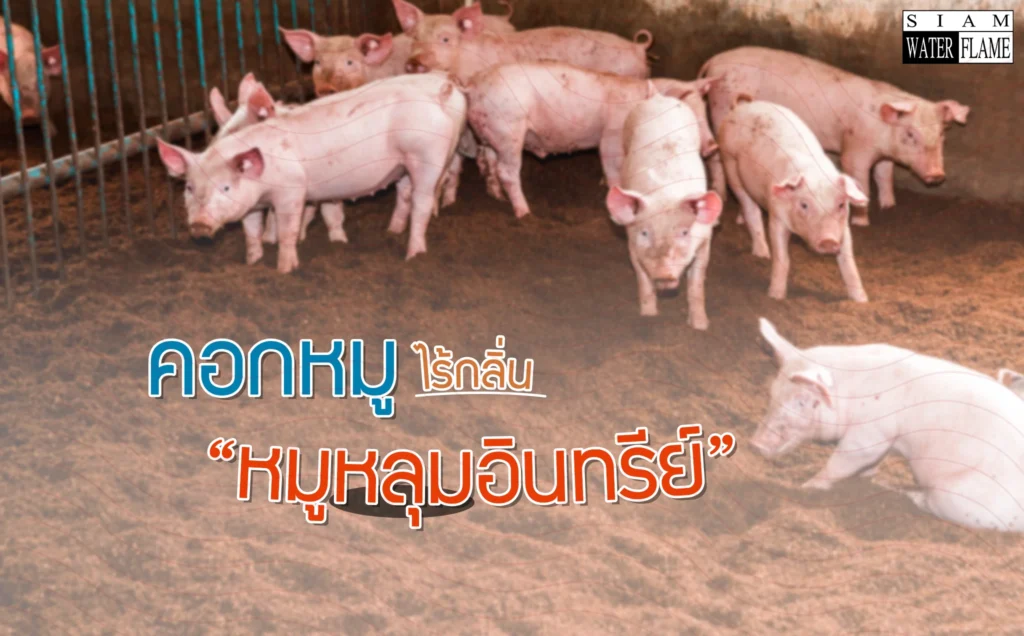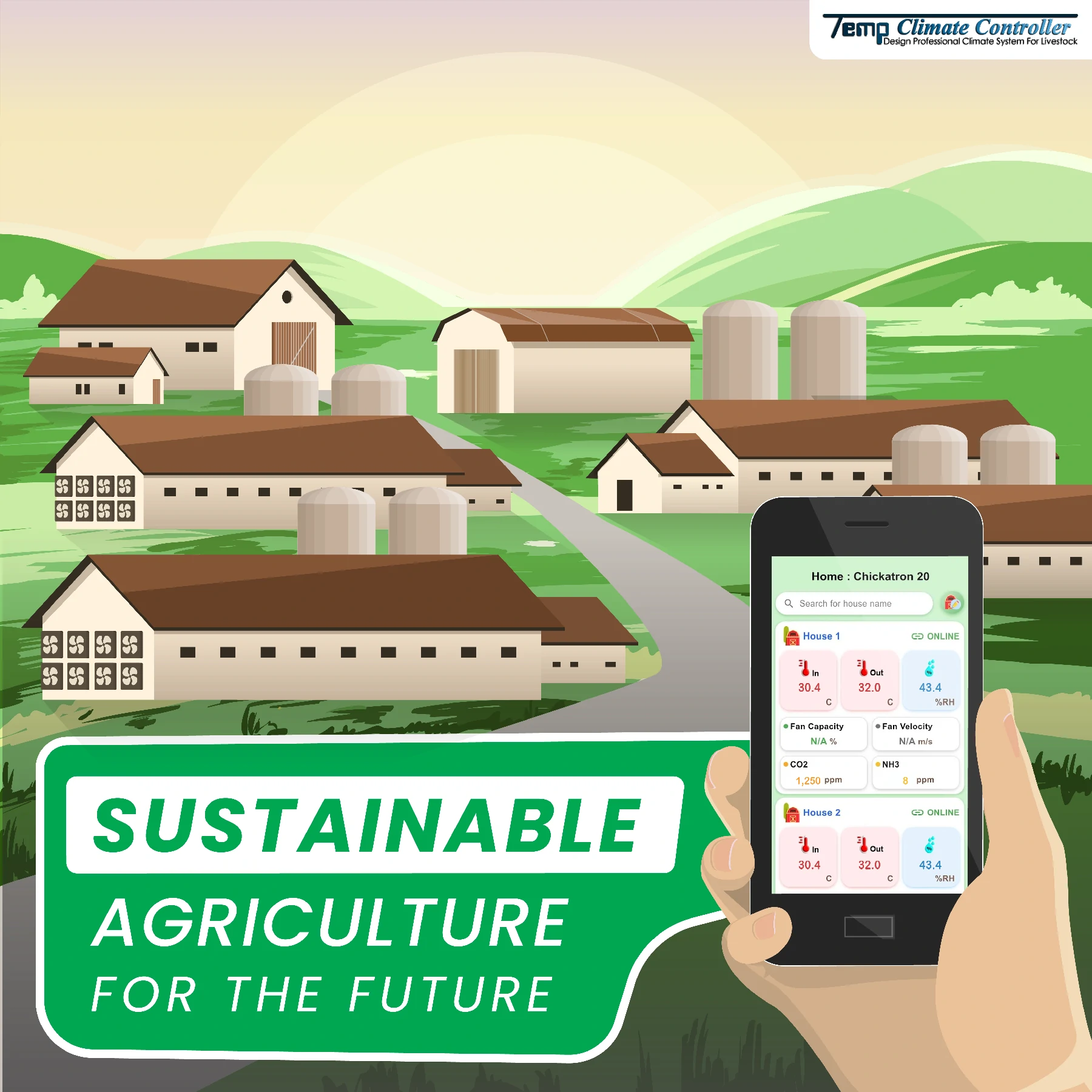Pig farming
benefits of raising
1.) Reduce food costs by up to 70%
2.) Reduce the burden of raising pigs for farmers. because there is no need to clean the stall floor
3.) Reduce pollution, waste from pig farming ” no bad smell There are no flies.”
4.) get organic fertilizer
5.) Can use various materials that are natural and local, easy to find, cheap.
6.) Does not cause problems to the environment due to pig manure and wastewater
7.) Can be raised in the community Because there is no problem with bad odor from droppings and flies.
8.) No cost for cleaning the pen and wastewater treatment.
9.) There is a naturally occurring circulation system in the pen or pit.
10.) Manure and materials in the pit, which are fermented and decomposed by microorganisms, become well composted, used as fertilizer for plants. Improve the soil, nourish the soil or sell it.
11.) Low production costs, especially food costs can be reduced by at least 70 percent.
12.) Avoid using chemicals or antibiotics. making the product safe for consumers
13.) To be used as part of sufficiency economy farming and organic farming system.
Construction of houses or pens for raising pit pigs
A pit pig pen is different from a general pig pen, in addition to having a wall separating the pen. Also dig a hole about 70 centimeters deep and put decomposed materials to replace the excavated soil. Stall partition walls, depending on the funding, may use bamboo, slats, and eucalyptus. Or it could be a brick block wall. Emphasis is placed on materials that are readily available. not too expensive Or the wall could be any type that would prevent the pigs from leaving the pen. be strong and long service life Do not repair too often Digging a pit, the size of the pit depends on the number of pigs to be reared. By requiring one pig to use the area from the beginning to the sale of 1.2-1.5 square meters. Digging holes can be dug before or after building the house. depending on the convenience of work
how to dig a hole

1.) Measure the length from the house pillar line. which will be in the same line as the wall separating the pen Measure inside all four sides, 30 centimeters each, then dig down to a depth of 70 – 90 centimeters (can be shallower).
2.) Divide the remaining edge of the hole in half. on all four sides and excavated to a depth of 30 centimeters, digging in the shape of an L shape (L).
3.) Use brick blocks to build on the L-shaped (L) on all four sides or may use a wooden form and pour concrete. to make concrete nails along the edge of the hole to prevent pigs from using their mouths to dig the edge of the hole
4.) Pour concrete floor lintels along the lines that will make the wall separating the pen on all sides.
5.) The excavated soil should be kept mixed with other materials to be put back into the hole as before.
Preparing the area for the pig pit stall
The materials used should be materials that are easy to find, inexpensive, generally available in nature, or other leftover materials that can be reused. Helps to save quite a lot of costs. The materials used are as follows:
1.) Rice husks, sawdust or agricultural materials, dry leaves, hay, chopped straw, residues from mushroom cultivation. or compostable dry waste
2.) Red soil or soil dug out of the hole
3.) Charcoal
4.) Table salt
5.) Natural white fungus found under different types of bamboo plants.
6.) Natural microbial fermentation from both plants and animals
steps and how to do
1.) Prepare a hole according to the size and number of pigs to be raised. with a depth of 90 centimeters
2.) The first layer (lowest layer) put rice husks, sawdust or other biodegradable materials about 35 centimeters or half the height of the hole. If the hole size is 3 meters wide, 3 meters long, and 70 centimeters deep, will put rice husks or sawdust. about 400 kg
3.) 2nd layer, add red soil or soil excavated from the hole by using 10% of the 1st layer or 40 kg.
4.) 3rd layer put wood charcoal using 10% of the 1st layer or 40 kg. The charcoal should be beaten as small as possible and put it all over the hole.
5.) 4th layer, add table salt by using 1% of the 1st layer or 4 kg. Sprinkle all over.
6.) Level 5 put dried manure. (Any dung) by using 10% of the 1st layer or 40 kg. Put it all over the hole.
7.) 6th floor, add rice husk or sawdust to fill the entire hole, do not let the edge of the hole be seen.
8.) When all kinds of materials have been put in all layers to be watered with fermented water from both natural microorganisms and white fungus in the ratio of 2 tablespoons per 10 liters of water mixed in the same lotus and watered until soaked.
9.) When all steps have been completed, leave it for 4 days and then bring the pigs to feed.
10.) When the pigs are raised Use the microbial fermentation water as specified in clause 8 to sprinkle or sprinkle over the pigs to clean the sewage attached to the pigs.
11.) Mix microbial fermented water in drinking water for pigs to drink. ratio as specified in each species
12 Keep the environment and greenhouses airy and well ventilated.
parenting management
Bringing piglets Kuan weighing from 15-20 kg.
During the first month, use soft pork pellets first. After that, as a young pig (30-40 kg weight), gradually switch to mixed food such as bran, broken rice and fermented plants. Vegetable scraps or local vegetables
Drinking water, use herbal fermented water, fruit fermented water at the rate of 2 tablespoons per 10 liters of water.
Use bio-fermented water to water the floor of the pen. once a week to help reduce odor
If sawdust or cover collapses, add again until it is level with the hole.
Marinated recipes for pitted pork
raw material
1.) 100 kg of green plants or fruits
2.) 4 kg of brown sugar
3.) 1 kg of table salt
how to do
1 Take fruits or green vegetables leftovers from household or agriculture such as bell peppers, bonbons, hemp, green plants or vegetable scraps to chop finely. 2 Mix together with cane sugar and table salt. 3 Packed into the fermentation tank with the remaining space of 1/3 of the tank, covered with paper that allows air to pass through and ferment for 7 days, if it is hot, 5 days can be used.
how to use
The fermented plant part was mixed with young rice bran and broken rice in the ratio of fermented plant: young bran: broken rice: equal to 2: 2: 1. The pigs ate 2 meals a day, morning and evening. to reduce the smell of pork
Pig farming
benefits of raising
1.) Reduce food costs by up to 70%
2.) Reduce the burden of raising pigs for farmers. because there is no need to clean the stall floor
3.) Reduce pollution, waste from pig farming ” no bad smell There are no flies.”
4.) get organic fertilizer
5.) Can use various materials that are natural and local, easy to find, cheap.
6.) Does not cause problems to the environment due to pig manure and wastewater
7.) Can be raised in the community Because there is no problem with bad odor from droppings and flies.
8.) No cost for cleaning the pen and wastewater treatment.
9.) There is a naturally occurring circulation system in the pen or pit.
10.) Manure and materials in the pit, which are fermented and decomposed by microorganisms, become well composted, used as fertilizer for plants. Improve the soil, nourish the soil or sell it.
11.) Low production costs, especially food costs can be reduced by at least 70 percent.
12.) Avoid using chemicals or antibiotics. making the product safe for consumers
13.) To be used as part of sufficiency economy farming and organic farming system.
Construction of houses or pens for raising pit pigs
A pit pig pen is different from a general pig pen, in addition to having a wall separating the pen. Also dig a hole about 70 centimeters deep and put decomposed materials to replace the excavated soil. Stall partition walls, depending on the funding, may use bamboo, slats, and eucalyptus. Or it could be a brick block wall. Emphasis is placed on materials that are readily available. not too expensive Or the wall could be any type that would prevent the pigs from leaving the pen. be strong and long service life Do not repair too often Digging a pit, the size of the pit depends on the number of pigs to be reared. By requiring one pig to use the area from the beginning to the sale of 1.2-1.5 square meters. Digging holes can be dug before or after building the house. depending on the convenience of work
how to dig a hole

1.) Measure the length from the house pillar line. which will be in the same line as the wall separating the pen Measure inside all four sides, 30 centimeters each, then dig down to a depth of 70 – 90 centimeters (can be shallower).
2.) Divide the remaining edge of the hole in half. on all four sides and excavated to a depth of 30 centimeters, digging in the shape of an L shape (L).
3.) Use brick blocks to build on the L-shaped (L) on all four sides or may use a wooden form and pour concrete. to make concrete nails along the edge of the hole to prevent pigs from using their mouths to dig the edge of the hole
4.) Pour concrete floor lintels along the lines that will make the wall separating the pen on all sides.
5.) The excavated soil should be kept mixed with other materials to be put back into the hole as before.
Preparing the area for the pig pit stall
The materials used should be materials that are easy to find, inexpensive, generally available in nature, or other leftover materials that can be reused. Helps to save quite a lot of costs. The materials used are as follows:
1.) Rice husks, sawdust or agricultural materials, dry leaves, hay, chopped straw, residues from mushroom cultivation. or compostable dry waste
2.) Red soil or soil dug out of the hole
3.) Charcoal
4.) Table salt
5.) Natural white fungus found under different types of bamboo plants.
6.) Natural microbial fermentation from both plants and animals
steps and how to do
1.) Prepare a hole according to the size and number of pigs to be raised. with a depth of 90 centimeters
2.) The first layer (lowest layer) put rice husks, sawdust or other biodegradable materials about 35 centimeters or half the height of the hole. If the hole size is 3 meters wide, 3 meters long, and 70 centimeters deep, will put rice husks or sawdust. about 400 kg
3.) 2nd layer, add red soil or soil excavated from the hole by using 10% of the 1st layer or 40 kg.
4.) 3rd layer put wood charcoal using 10% of the 1st layer or 40 kg. The charcoal should be beaten as small as possible and put it all over the hole.
5.) 4th layer, add table salt by using 1% of the 1st layer or 4 kg. Sprinkle all over.
6.) Level 5 put dried manure. (Any dung) by using 10% of the 1st layer or 40 kg. Put it all over the hole.
7.) 6th floor, add rice husk or sawdust to fill the entire hole, do not let the edge of the hole be seen.
8.) When all kinds of materials have been put in all layers to be watered with fermented water from both natural microorganisms and white fungus in the ratio of 2 tablespoons per 10 liters of water mixed in the same lotus and watered until soaked.
9.) When all steps have been completed, leave it for 4 days and then bring the pigs to feed.
10.) When the pigs are raised Use the microbial fermentation water as specified in clause 8 to sprinkle or sprinkle over the pigs to clean the sewage attached to the pigs.
11.) Mix microbial fermented water in drinking water for pigs to drink. ratio as specified in each species
12 Keep the environment and greenhouses airy and well ventilated.
parenting management
Bringing piglets Kuan weighing from 15-20 kg.
During the first month, use soft pork pellets first. After that, as a young pig (30-40 kg weight), gradually switch to mixed food such as bran, broken rice and fermented plants. Vegetable scraps or local vegetables
Drinking water, use herbal fermented water, fruit fermented water at the rate of 2 tablespoons per 10 liters of water.
Use bio-fermented water to water the floor of the pen. once a week to help reduce odor
If sawdust or cover collapses, add again until it is level with the hole.
Marinated recipes for pitted pork
raw material
1.) 100 kg of green plants or fruits
2.) 4 kg of brown sugar
3.) 1 kg of table salt
how to do
1 Take fruits or green vegetables leftovers from household or agriculture such as bell peppers, bonbons, hemp, green plants or vegetable scraps to chop finely. 2 Mix together with cane sugar and table salt. 3 Packed into the fermentation tank with the remaining space of 1/3 of the tank, covered with paper that allows air to pass through and ferment for 7 days, if it is hot, 5 days can be used.
how to use
The fermented plant part was mixed with young rice bran and broken rice in the ratio of fermented plant: young bran: broken rice: equal to 2: 2: 1. The pigs ate 2 meals a day, morning and evening. to reduce the smell of pork
Pig farming
benefits of raising
1.) Reduce food costs by up to 70%
2.) Reduce the burden of raising pigs for farmers. because there is no need to clean the stall floor
3.) Reduce pollution, waste from pig farming ” no bad smell There are no flies.”
4.) get organic fertilizer
5.) Can use various materials that are natural and local, easy to find, cheap.
6.) Does not cause problems to the environment due to pig manure and wastewater
7.) Can be raised in the community Because there is no problem with bad odor from droppings and flies.
8.) No cost for cleaning the pen and wastewater treatment.
9.) There is a naturally occurring circulation system in the pen or pit.
10.) Manure and materials in the pit, which are fermented and decomposed by microorganisms, become well composted, used as fertilizer for plants. Improve the soil, nourish the soil or sell it.
11.) Low production costs, especially food costs can be reduced by at least 70 percent.
12.) Avoid using chemicals or antibiotics. making the product safe for consumers
13.) To be used as part of sufficiency economy farming and organic farming system.
Construction of houses or pens for raising pit pigs
A pit pig pen is different from a general pig pen, in addition to having a wall separating the pen. Also dig a hole about 70 centimeters deep and put decomposed materials to replace the excavated soil. Stall partition walls, depending on the funding, may use bamboo, slats, and eucalyptus. Or it could be a brick block wall. Emphasis is placed on materials that are readily available. not too expensive Or the wall could be any type that would prevent the pigs from leaving the pen. be strong and long service life Do not repair too often Digging a pit, the size of the pit depends on the number of pigs to be reared. By requiring one pig to use the area from the beginning to the sale of 1.2-1.5 square meters. Digging holes can be dug before or after building the house. depending on the convenience of work
how to dig a hole
1.) Measure the length from the house pillar line. which will be in the same line as the wall separating the pen Measure inside all four sides, 30 centimeters each, then dig down to a depth of 70 – 90 centimeters (can be shallower).
2.) Divide the remaining edge of the hole in half. on all four sides and excavated to a depth of 30 centimeters, digging in the shape of an L shape (L).
3.) Use brick blocks to build on the L-shaped (L) on all four sides or may use a wooden form and pour concrete. to make concrete nails along the edge of the hole to prevent pigs from using their mouths to dig the edge of the hole
4.) Pour concrete floor lintels along the lines that will make the wall separating the pen on all sides.
5.) The excavated soil should be kept mixed with other materials to be put back into the hole as before.
Preparing the area for the pig pit stall
The materials used should be materials that are easy to find, inexpensive, generally available in nature, or other leftover materials that can be reused. Helps to save quite a lot of costs. The materials used are as follows:
1.) Rice husks, sawdust or agricultural materials, dry leaves, hay, chopped straw, residues from mushroom cultivation. or compostable dry waste
2.) Red soil or soil dug out of the hole
3.) Charcoal
4.) Table salt
5.) Natural white fungus found under different types of bamboo plants.
6.) Natural microbial fermentation from both plants and animals
steps and how to do
1.) Prepare a hole according to the size and number of pigs to be raised. with a depth of 90 centimeters
2.) The first layer (lowest layer) put rice husks, sawdust or other biodegradable materials about 35 centimeters or half the height of the hole. If the hole size is 3 meters wide, 3 meters long, and 70 centimeters deep, will put rice husks or sawdust. about 400 kg
3.) 2nd layer, add red soil or soil excavated from the hole by using 10% of the 1st layer or 40 kg.
4.) 3rd layer put wood charcoal using 10% of the 1st layer or 40 kg. The charcoal should be beaten as small as possible and put it all over the hole.
5.) 4th layer, add table salt by using 1% of the 1st layer or 4 kg. Sprinkle all over.
6.) Level 5 put dried manure. (Any dung) by using 10% of the 1st layer or 40 kg. Put it all over the hole.
7.) 6th floor, add rice husk or sawdust to fill the entire hole, do not let the edge of the hole be seen.
8.) When all kinds of materials have been put in all layers to be watered with fermented water from both natural microorganisms and white fungus in the ratio of 2 tablespoons per 10 liters of water mixed in the same lotus and watered until soaked.
9.) When all steps have been completed, leave it for 4 days and then bring the pigs to feed.
10.) When the pigs are raised Use the microbial fermentation water as specified in clause 8 to sprinkle or sprinkle over the pigs to clean the sewage attached to the pigs.
11.) Mix microbial fermented water in drinking water for pigs to drink. ratio as specified in each species
12 Keep the environment and greenhouses airy and well ventilated.
parenting management
Bringing piglets Kuan weighing from 15-20 kg.
During the first month, use soft pork pellets first. After that, as a young pig (30-40 kg weight), gradually switch to mixed food such as bran, broken rice and fermented plants. Vegetable scraps or local vegetables
Drinking water, use herbal fermented water, fruit fermented water at the rate of 2 tablespoons per 10 liters of water.
Use bio-fermented water to water the floor of the pen. once a week to help reduce odor
If sawdust or cover collapses, add again until it is level with the hole.
Marinated recipes for pitted pork
raw material
1.) 100 kg of green plants or fruits
2.) 4 kg of brown sugar
3.) 1 kg of table salt
how to do
1 Take fruits or green vegetables leftovers from household or agriculture such as bell peppers, bonbons, hemp, green plants or vegetable scraps to chop finely. 2 Mix together with cane sugar and table salt. 3 Packed into the fermentation tank with the remaining space of 1/3 of the tank, covered with paper that allows air to pass through and ferment for 7 days, if it is hot, 5 days can be used.
how to use
The fermented plant part was mixed with young rice bran and broken rice in the ratio of fermented plant: young bran: broken rice: equal to 2: 2: 1. The pigs ate 2 meals a day, morning and evening. to reduce the smell of pork








